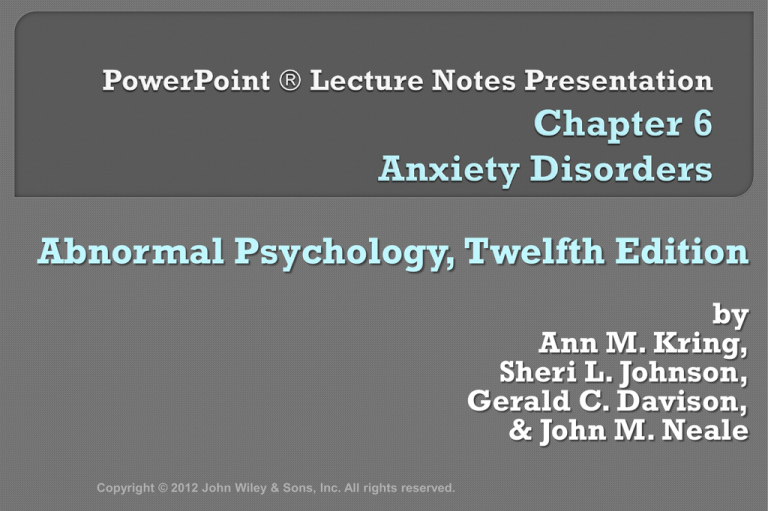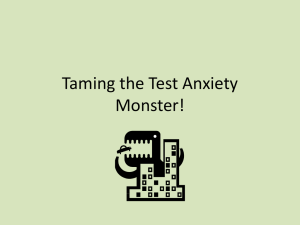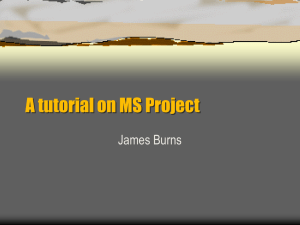
Abnormal Psychology, Twelfth Edition
by
Ann M. Kring,
Sheri L. Johnson,
Gerald C. Davison,
& John M. Neale
Copyright © 2012 John Wiley & Sons, Inc. All rights reserved.
Chapter
6: Anxiety Disorders
I. Clinical Descriptions of Anxiety Disorders
II. Common Risk Factors Across the Anxiety
Disorders
III. Treatment of Anxiety Disorders
© 2012 John Wiley & Sons, Inc. All rights reserved.
Anxiety
• Apprehension about a future threat
Fear
• Response to an immediate threat
Both
involve physiological arousal
Both
can be adaptive
• Sympathetic nervous system
• Fear triggers “fight or flight ”
May save life
• Anxiety increases preparedness
“U-shaped” curve (Yerkes & Dodson, 1908)
Absence of anxiety interferes with performance
Moderate levels of anxiety improve performance
High levels of anxiety are detrimental to performance
© 2012 John Wiley & Sons, Inc. All rights reserved.
DSM-5 Anxiety Disorders
• Specific phobias
• Social anxiety disorder
• Panic disorder
• Agoraphobia
• Generalized anxiety disorder
Most common psychiatric
disorders
28% report anxiety symptoms
Most common are phobias
© 2012 John Wiley & Sons, Inc. All rights reserved.
The DSM-IV-TR Anxiety
Disorders have been
divided into three
chapters in the proposed
DSM-5: Anxiety
Disorders, ObsessiveCompulsive and Related
Disorders, and Traumaand Stressor-Related
Disorders. Agoraphobia
has been changed from a
subtype of panic disorder
to a diagnosis in its own
right.
© 2012 John Wiley & Sons, Inc. All rights reserved.
© 2012 John Wiley & Sons, Inc. All rights reserved.
Disruptive
fear of a particular object or situation
• Fear out of proportion to actual threat
• Awareness that fear is excessive
• Must be severe enough to cause distress or interfere
with job or social life
Avoidance
© 2012 John Wiley & Sons, Inc. All rights reserved.
Disproportionate
fear of a particular object or
situation
• Common examples: fear of flying, snakes, heights, etc.
• Fear out of proportion to actual threat
• Awareness that fear is excessive
• Most specific phobias cluster around a few feared objects
and situations
• High comorbidity of specific phobias
© 2012 John Wiley & Sons, Inc. All rights reserved.
Marked and disproportionate fear consistently
triggered by specific objects or situations
The object or situation is avoided or else endured
with intense anxiety
Symptoms persist for at least 6 months
• Note: The DSM-IV-TR criterion that the person recognizes
that the fear is unrealistic is not included in DSM-5.
• DSM-IV-TR includes the duration criterion only for those
under age 18
© 2012 John Wiley & Sons, Inc. All rights reserved.
© 2012 John Wiley & Sons, Inc. All rights reserved.
© 2012 John Wiley & Sons, Inc. All rights reserved.
Called Social Phobia in DSM-IV-TR
• Causes more life disruption than other phobias
More intense and extensive than shyness
• Persistent, intense fear and avoidance of social situations
• Fear of negative evaluation or scrutiny
• Exposure to trigger leads to anxiety about being
humiliated or embarrassed socially
• Onset often adolescence
33% also diagnosed with Avoidant Personality Disorder
• Overlap in genetic vulnerability for both disorders
© 2012 John Wiley & Sons, Inc. All rights reserved.
Marked and disproportionate fear consistently triggered by
exposure to potential social scrutiny
Exposure to the trigger leads to intense anxiety about being
evaluated negatively
Trigger situations are avoided or else endured with intense
anxiety
Symptoms persist for at least 6 months.
• Note: DSM-IV-TR labels this disorder as social phobia
• The DSM-IV-TR, but not the DSM-5, specifies that the person recognizes the
fear is unrealistic
• DSM-IV-TR includes the duration criterion only for those under age 18
© 2012 John Wiley & Sons, Inc. All rights reserved.
Frequent
panic attacks unrelated to specific
situations
Panic attack
• Sudden, intense episode of apprehension, terror,
feelings of impending doom
Intense urge to flee
Symptoms reach peak intensity within 10 minutes
• Physical symptoms can include:
Labored breathing, heart palpitations, nausea, upset stomach,
chest pain, feelings of choking and smothering, dizziness,
sweating, lightheadedness, chills, heat sensations, and trembling
• Other symptoms may include:
Depersonalization
Derealization
Fears of going crazy, losing control, or dying
© 2012 John Wiley & Sons, Inc. All rights reserved.
Uncued
attacks
• Occur unexpectedly without warning
• Panic disorder diagnosis requires recurrent uncued
attacks
• Causes worry about future attacks
Cued
attacks
• Triggered by specific situations (e.g., seeing a
snake)
More likely a phobia
© 2012 John Wiley & Sons, Inc. All rights reserved.
Recurrent
uncued panic attacks
At least 1 month of concern about the
possibility of more attacks, worry about the
consequences of an attack, or behavioral
changes because of the attacks
© 2012 John Wiley & Sons, Inc. All rights reserved.
From
the Greek word “agora” or marketplace
Anxiety about inability to flee anxietyprovoking situations
• E.g., crowds, stores, malls, churches, trains, bridges,
tunnels, etc.
• Causes significant impairment
In
DSM-IV-TR, was a subtype of Panic
Disorder
• Al least half of agoraphobics do not suffer panic attacks
© 2012 John Wiley & Sons, Inc. All rights reserved.
Disproportionate and marked fear or anxiety about
at least 2 situations where it would be difficult to
escape or receive help in the event of incapacitation
or panic-like symptoms, such as:
• being outside of the home alone; traveling on public
transportation; open spaces such as parking lots and
marketplaces; being in shops, theaters, or cinemas; standing
in line or being in a crowd
These situations consistently provoke fear or
anxiety
These situations are avoided, require the presence
of a companion, or are endured with intense fear or
anxiety
Symptoms last at least 6 months
© 2012 John Wiley & Sons, Inc. All rights reserved.
Involves
worry
chronic, excessive, uncontrollable
• Lasts at least 6 months
• Interferes with daily life
Often cannot decide on a solution or course of action
Other symptoms:
• Restlessness, poor concentration, tiring easily,
restlessness, irritability, muscle tension
Common worries:
• Relationships, health, finances, daily hassles
Often begins in adolescence or earlier
• I’ve always been this way
© 2012 John Wiley & Sons, Inc. All rights reserved.
Excessive anxiety and worry at least 50 percent of days about at least two
life domains (e.g., family, health, finances, work, and school)
The worry is sustained for at least 3 months
The anxiety and worry are associated with at least three of the following:
•
•
•
•
•
•
1. restlessness or feeling keyed up or on edge
2. being easily fatigued
3. difficulty concentrating or mind going blank
4. irritability
5. muscle tension
6. sleep disturbance
The anxiety and worry are associated with marked avoidance of situations
in which negative outcomes could occur, marked time and effort preparing
for situations that might have a negative outcome, marked procrastination,
difficulty making decisions due to worries, or repeatedly seeking
reassurance due to worries
• Note: Italics reflect changes introduced in DSM-5.
• The DSM-IV-TR criterion that the person finds it hard to control the worry is not included
in DSM-5.
• The DSM-IV-TR criteria specify duration of 6 months rather than 3 months.
• DSM-IV-TR criteria specified that the anxiety was about a number of events or activities.
© 2012 John Wiley & Sons, Inc. All rights reserved.
80%
of those with anxiety disorder meet criteria
for another anxiety disorder
• Subthreshold symptoms (do not meet full DSM) very
common
• Causes of comorbidity
Symptoms used to diagnose the various anxiety disorders overlap:
Social anxiety and agoraphobia might both involve a fear of crowds
Etiological factors may increase risk for more than one anxiety
disorder
75%
of those with anxiety disorder meet criteria
for another psychological disorder
• Disorders commonly comorbid with anxiety:
60% with anxiety also have depression
Substance abuse
Personality disorders
Medical disorders, e.g. coronary heart disease
© 2012 John Wiley & Sons, Inc. All rights reserved.
Women are twice as likely as men to have anxiety
disorder
• Possible explanations
Women may be more likely to report symptoms
Men more likely to be encouraged to face fears
Women more likely to experience childhood sexual abuse
Women show more biological stress reactivity
Cultural factors
• Culturally specific syndromes
Taijin kyofusho
Japanese fear of offending or embarrassing others
Kayak-angst
Inuit disorder in seal hunters at sea similar to panic
• Ratio of somatic to psychological symptoms appears
similar across cultures (Kirmayer, 2001)
© 2012 John Wiley & Sons, Inc. All rights reserved.
© 2012 John Wiley & Sons, Inc. All rights reserved.
Behavioral
conditioning
Genetic vulnerability
Increased activity in the fear circuit of the brain
Decreased functioning of GABA and serotonin;
increased norepinephrine activity
Behavioral inhibition
Neuroticism
Cognitive factors, including sustained negative
beliefs, perceived lack of control, and attention
to cues of threat
© 2012 John Wiley & Sons, Inc. All rights reserved.
Conditioning
Mowrer’s two-factor
model
• Pairing of stimulus
with aversive UCS
leads to fear (Classical
Conditioning)
• Avoidance maintained
though negative
reinforcement
(Operant Conditioning)
© 2012 John Wiley & Sons, Inc. All rights reserved.
Extensions
of the two-factor model
• Modeling
Seeing another person harmed by the stimulus
• Verbal instruction
Parent warning a child about a danger
• Those with anxiety tend to acquire fear more
readily
And to be more resistant to extinction
© 2012 John Wiley & Sons, Inc. All rights reserved.
Genetic
• Twin studies suggest heritability
About 20-40% for phobias, GAD, and
PTSD
About 50% for panic disorder
• Relative with phobia increases
risk for other anxiety disorders in
addition to phobia
Neurobiological
• Fear circuit overactivity
Amygdala
Medial prefrontal cortex deficits
• Neurotransmitters
Poor functioning of serotonin and
GABA
Higher levels of norepinephrine
© 2012 John Wiley & Sons, Inc. All rights reserved.
Behavioral
inhibition
• Tendency to be agitated, distressed, and cry in
unfamiliar or novel settings
Observed in infants as young as 4 months
May be inherited
• Predicts anxiety in childhood and social anxiety in
adolescence
Neuroticism
• React with negative affect
• Linked to anxiety and depression
• Higher levels linked to double the likelihood of
developing anxiety disorders
© 2012 John Wiley & Sons, Inc. All rights reserved.
Sustained negative beliefs about future
• Bad things will happen
• Engage in safety behaviors
Belief that one lacks control over
environment
• More vulnerable to developing anxiety disorder
Childhood trauma or punitive parenting may foster beliefs
Serious life events can threaten sense of control
Attention to threat
• Tendency to notice negative environmental cues
Selective attention to signs of threat
© 2012 John Wiley & Sons, Inc. All rights reserved.
© 2012 John Wiley & Sons, Inc. All rights reserved.
Two-factor
model of behavioral
conditioning
• Conditioned responses to threat
• Sustained by avoidance or safety behaviors
Avoid eye contact, appear aloof, stand apart from others
in social settings
Risk factors act as diatheses
• Vulnerabilities influence development of phobias
Prepared learning
• Evolutionary preparation to fear certain stimuli
Potentially life-threatening (heights, snakes, etc.)
© 2012 John Wiley & Sons, Inc. All rights reserved.
Cognitive
factors
• Unrealistic negative beliefs about consequences of
behaviors
• Excessive attention to internal cues
• Fear of negative evaluation by others
Expect others to dislike them
• Negative self evaluation
Harsh, punitive self-judgment
© 2012 John Wiley & Sons, Inc. All rights reserved.
Neurobiological
factors
• Locus ceruleus
Major source of
norepinephrine
A trigger for nervous system
activity
© 2012 John Wiley & Sons, Inc. All rights reserved.
Interoceptive
conditioning
• Classical conditioning of
panic in response to
internal bodily sensations
© 2012 John Wiley & Sons, Inc. All rights reserved.
Cognitive
factors
• Catastrophic
misinterpretations of somatic
changes
Interpreted as impending doom
I must be having a heart attack!
Beliefs increase anxiety and
arousal
Creates vicious cycle
Anxiety
Sensitivity Index
• High scores predict development of
panic
“Unusual body sensations scare me.”
“When I notice that my heart is beating rapidly, I
worry that I might have a heart attack.”
© 2012 John Wiley & Sons, Inc. All rights reserved.
Fear-of-fear
hypothesis (Goldstein & Chambless,
1978)
• Expectations about the catastrophic consequences
of having a public panic attack
What will people think of me?!?!
© 2012 John Wiley & Sons, Inc. All rights reserved.
GABA
system deficits
Borkovec’s cognitive model:
• Worry reinforcing because it distracts from
negative emotions and images
• Allows avoidance of more disturbing emotions
e.g., distress of previous trauma
• Worrying decreases psychophysiological arousal
• Avoidance prevents extinction of underlying anxiety
© 2012 John Wiley & Sons, Inc. All rights reserved.
© 2012 John Wiley & Sons, Inc. All rights reserved.
Psychological
treatments emphasize
Exposure
• Face the situation or object that triggers anxiety
Should include as many features of the trigger as possible
Should be conducted in as many settings as possible
70-90% effective
Systematic desensitization
• Relaxation plus imaginal exposure
Cognitive
approaches
• Increase belief in ability to cope with the anxiety trigger
• Challenge expectations about negative outcomes
© 2012 John Wiley & Sons, Inc. All rights reserved.
Phobias
• Exposure
In vivo (real-life) exposure more effective than systematic
desensitization
Social Anxiety
• Exposure
Disorder
Role playing or small group interaction
• Social skills training
Reduce use of safety behaviors
• Cognitive therapy
Clark’s (2003) cognitive therapy more effective than
medication or exposure
© 2012 John Wiley & Sons, Inc. All rights reserved.
Panic
Control Therapy (PCT; Craske &
Barlow, 2001)
• Exposure to somatic sensations associated with
panic attack in a safe setting
Increased heart rate, rapid breathing, dizziness
• Use of coping strategies to control symptoms
Relaxation
Deep breathing
• PCT benefits maintained after treatment ends
© 2012 John Wiley & Sons, Inc. All rights reserved.
Cognitive Behavioral Therapy (CBT)
• Systematic exposure to feared situations
• Self-guided treatment effective
© 2012 John Wiley & Sons, Inc. All rights reserved.
Relaxation
training
Cognitive Behavioral methods
• Challenge and modify negative thoughts
• Increase ability to tolerate uncertainty
• Worry only during “scheduled” times
• Focus on present moment
© 2012 John Wiley & Sons, Inc. All rights reserved.
Anxiolytics: drugs
• Benzodiazepenes
that reduce anxiety
Valium
Xanax
• Antidepressants
Tricyclics
Selective Serotonin Reuptake Inhibitors (SSRIs)
Serotonin-Norepinephrine Reuptake Inhibitors (SNRIs)
• D-cycloserine (DCS)
Enhances learning during exposure treatment
© 2012 John Wiley & Sons, Inc. All rights reserved.
Copyright 2012 by John Wiley & Sons, Inc. All
rights reserved. No part of the material protected
by this copyright may be reproduced or utilized in
any form or by any means, electronic or
mechanical, including photocopying, recording
or by any information storage and retrieval
system, without written permission of the
copyright owner.
© 2012 John Wiley & Sons, Inc. All rights reserved.









